Fond memories of growing up in Ardsley
Chapel Street
No.2 Chapel St. was our family home for generations. I was born there in April 1950. It was also the birthplace of my mum, her sister and her two brothers. William Poulter my grandad and Polly Poulter (nee Rymer) my grandma, moved into the house after getting married in 1893. I never knew either, as William died as long ago as 1912, and Polly died in 1946.
Polly with her sister Annie, who lived next door at No.1 Chapel St. were the proprietors of Ardsley’s Fish and Chip shop, which in those days was a wooden hut situated in the yard of the Coach & Horses !
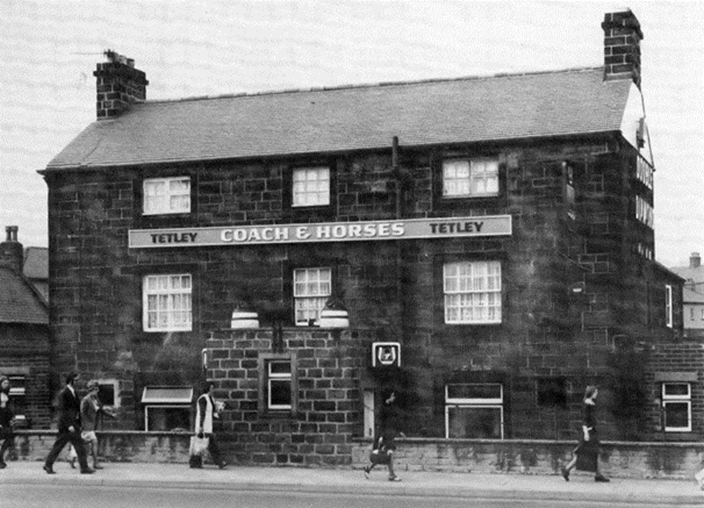
The sadly missed ‘Coach’, seen here sometime in the 1960s. Grandma Polly’s Fish & Chip shop must have been down the side of the pub somewhere. Built as far back as 1798, the pub was demolished in 2003, despite a campaign to save it. In fairly recent years historic buildings such as this seem to count for nothing to the local powers that be, as the same fate befell two other local historic public houses, the ‘Cross Keys’ built c1690, demolished in 1999 and the ‘Black Bull’ built in 1773, demolished as recently as 2019.
As a kid in the 1950s No. 1 Chapel St. was the home of my Uncle Len (Poulter). After Annie had died in 1939, he moved there all the way from No.2, after marrying my Auntie Elsie, who prior to marriage was Elsie Bird, and also the auntie of Barnsley cricketing legend Dickie Bird.
Next door at No. 3 Chapel St. lived Mr & Mrs Howard (Oliver and Adeline). No 4 was the corner shop run by Reg & Cath Francis. Mr Francis, being a shopkeeper had a car ! The only one on the entire street. A black Humber Hawk. It would sometimes be parked outside the back of the shop, almost outside our back door. To six-year-old me this car seemed absolutely enormous.
Next door at No. 3 Chapel St. lived Mr & Mrs Howard (Oliver and Adeline). No 4 was the corner shop run by Reg & Cath Francis. Mr Francis, being a shopkeeper had a car ! The only one on the entire street. A black Humber Hawk. It would sometimes be parked outside the back of the shop, almost outside our back door. To six-year-old me this car seemed absolutely enormous.
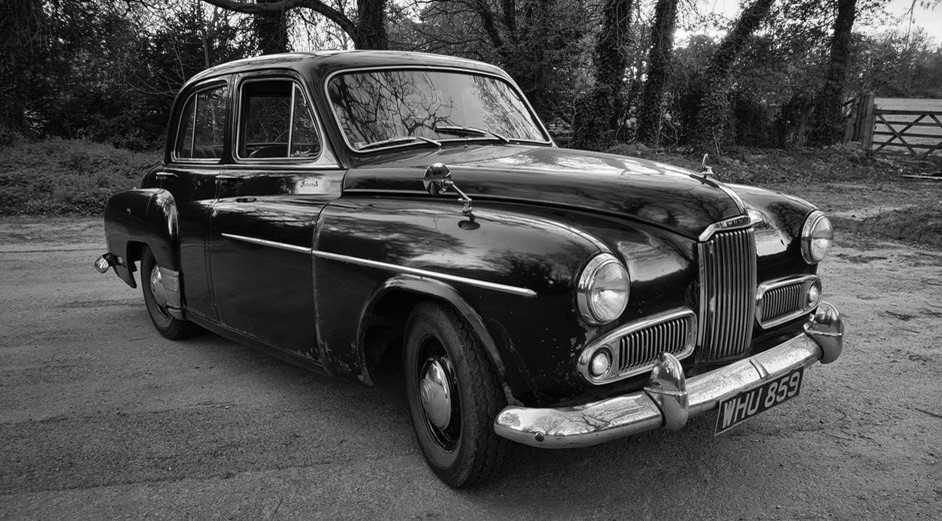
The 1956 Humber Hawk Mk VI
These house numbers changed in the 1950s, when the Post Office renumbered our side of the street to odd numbers. No. 2 Chapel Street then became No. 3, etc.
Because the houses on Chapel St. form an ‘L’ shape it wasn’t possible for them to have their own gardens. Instead there was one large backyard, with on the lefthand side a row of coal-places and then a wash house, almost no longer used, as most houses had a washing machine by then. Beyond that were the outside toilets, either side of a ‘midden’ which held the dustbins of the first half dozen houses. This kept all the dustbins nicely out of the way and out of sight, far better than the bins situation of today.
This wasn’t the case with the toilets however. Not only were they a hundred feet or more from the back door – there weren’t as many toilets as houses. This meant some houses shared with their next-door neighbours. We shared with Uncle Len which wasn’t so bad – unless you’d trailed up the yard in the dark with your torch, only to discover it was already ‘engaged’. Most of the winter an oil lamp would be inside, permanently lit, to prevent everything from freezing up.
Our ‘bathroom’ spent most of its week hanging on a nail outside our back door. Friday night was bath night, with the tin bath in front of the fire, and my Dad continually topping up the water with the kettle. Privacy was maintained with our wooden clothes horse placed around the bath and draped with blankets. Nowadays this lifestyle sounds pretty grim, but as you don’t miss what you’ve never had, it all seemed perfectly normal at the time.
Monday was washday. Washing lines stretched from each backdoor across the open yard to the outbuildings on the other side. Occasionally a delivery of home coal arrived on a Monday as well. This was great entertainment ! The coal lorry would appear at the top end of the yard, and then just like a Le Man’s start, a flurry of housewives would burst out of each house in a race to get the washing in before the coal lorry slowly drove underneath it all. Such fun to watch as a six-year-old.
Early Memories
What I reckon must be my earliest memory, is arriving home with my mum after a shopping trip to Barnsley. We’d returned home ‘on’t Ardsley’ (Tracky route 71) which stopped right outside our house on Chapel St. On walking in, rather strangely for daytime, the living room was in darkness, with curtains drawn. I then realised that it was packed. People were sitting and standing wherever they could, all staring at a large box in the corner. My dad had recently bought a telly, the first one on the street, and the room was filled with our neighbours. The whole street was in our tiny living room staring at a 12-inch screen – watching the Queen’s Coronation.
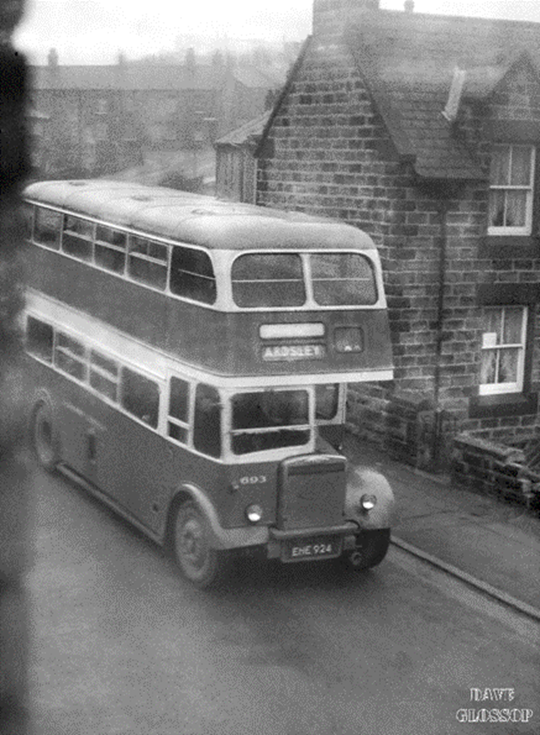
The Ardsley bus heading back to town, taken from the bedroom window of our house on Chapel St. in 1967. Coronation Terrace can be seen in the background. For anyone interested: It is 693 (formerly 977) EHE924 a Leyland Titan PD2/12 with Northern Counties bodywork, built in 1953
Another early memory, and another royal one, was a year later when the Queen went on a tour of the country, including Barnsley. My Mum took me with her, and there I stood with the crowds at Stairfoot, right outside the Black Bull, waving my Union Jack as the motorcade slowly passed by, with the Queen doing her royal wave back.
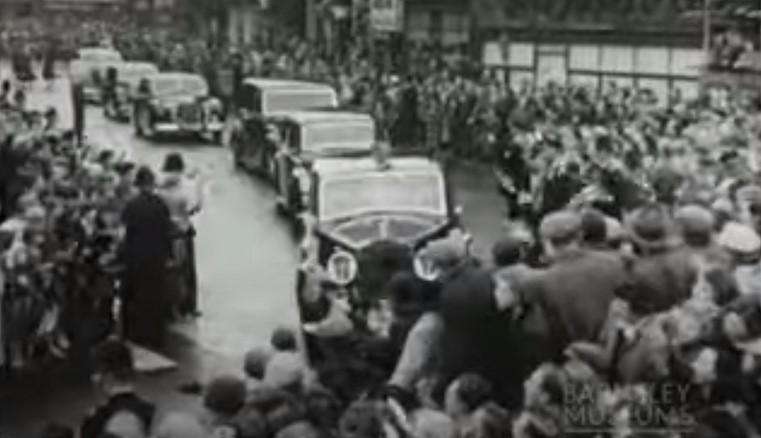
The motorcade slightly earlier on Eldon Street, en-route to Stairfoot
The Welfare
Ardsley Welfare, or to give it its official title: ‘Ardsley Miners Welfare Recreation Ground’ was a great place for us kids with various swings and rides. It had a couple of seesaws, a slide and a thing we knew as ‘The Swagger’. This was a lethal contraption with a huge wooden central beam to sit on, which swung back and forth with great force. How anyone didn’t get killed by it, is a mystery. Then one day the swing part of it disappeared. Someone at the council must have realised what a danger it was. A gentler ride was this roundabout. Not long after this photo it was also removed and replaced with a more mundane smaller ride, which I think we called the ‘Threepenny Bit’.
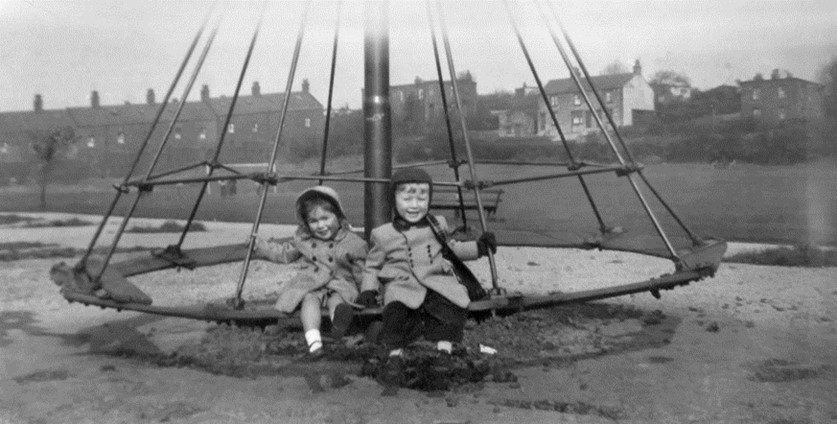
The original roundabout, with me and my cousin Pamela (Glossop) on board. The building second from the right in the distance is the former ‘Mount Pleasant Inn’. It had the nickname of ‘The Drop’, because occasionally, drinkers would fall down the flight of front steps or fall over the drop into the allotments in front. Built in 1856, it closed in 1925, and was converted into dwellings, which are still there today.
A Most Unusual Sight
Another fond memory is of standing one winter’s day with my Mum at the bus stop across from the Coach & Horses. We were waiting for the 14 or the 37, to go to town (or it might have been for the fondly remembered ‘Camps’ – Camplejohn’s of Darfield. Swallowed up by ‘Tracky’ as long ago as 1961). Then, in the distance, a banging and clattering noise slowly became louder and louder. The whole bus queue turned and looked up towards Lees Hill where, right in the distance a car heading in our direction was literally bouncing along and with sparks flying from its wheels on the tarmac. Now, it had snowed heavily a few weeks before, but by now the snow had long since gone. As the car eventually reached us, literally bouncing past and making an almighty racket and sparks still flying, the whole bus queue started to laugh.
The reason for all the noise was because all four wheels of the car still had snow chains on, fitted weeks earlier for the by now, long departed snow conditions. Behind the wheel of his Ford Zodiac, heading for Barnsley, desperately hanging onto the steering wheel, was Squire Micklethwait*.
*Squire Micklethwait was the Lord of the Manor of Ardsley. He was a rather tall, very slim, somewhat eccentric chap, well known to everyone in the village. In the 17th century the family had become one of the largest landowners of Ardsley.
The Destruction of the Old Village
At about eight or nine years old, me and my pals would walk up the village after school to watch loads of old houses being demolished, to make way for the new dual carriageway. By sitting on the church wall we had a perfect view of the demolition work underway across the road. The demolition contractor was Albert Dickinson, and in those days long before JCBs came along, the demolition vehicles were Chasesides, built by Chaseside, of Hertford.
To us eight-year-olds this was great fun, but what we didn’t appreciate was that what we were actually witnessing was the destruction of Barnsley’s quaintest village. Many of the buildings were over 200 years old, with two around 500 years old. An article appeared in the Barnsley Chronicle at the time written by Robin Morgan, who felt that the demolition of Ardsley was one of the worst acts of municipal vandalism he had ever witnessed.
A line from the article says: ‘The residents will look upon Christmas 1958 with heavy hearts and remember it as the time the village received its death sentence.’

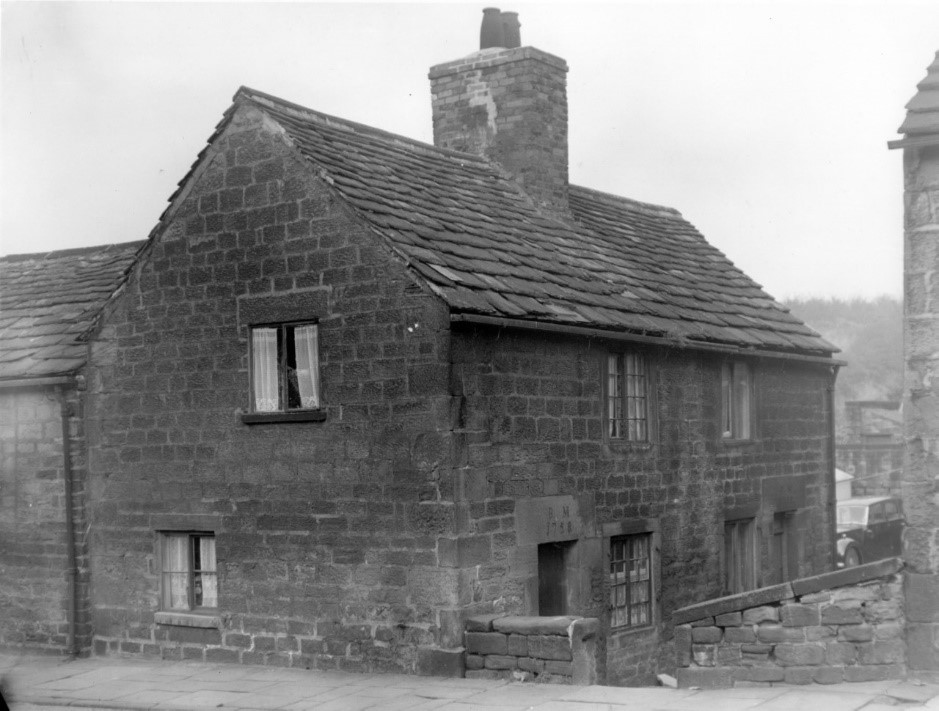
Two of the ancient buildings about to be demolished. This one is dated 1758
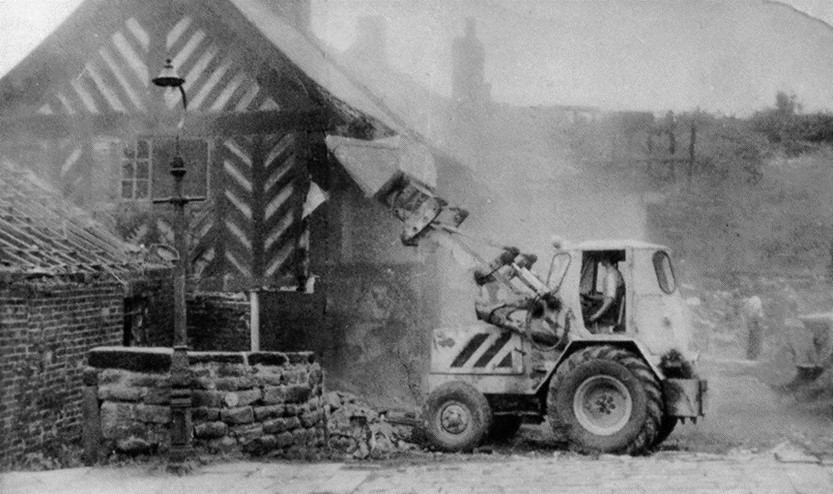
The half-timbered Tudor building on Church Street (Doncaster Road). To see this picture is still heart rending, even now.
The Club Trip
A great day out was on one summer’s day when I was about six or seven, when my grandma (my dad’s mum) took me on the annual Ashfield Club trip. This was a special train purely for club members’ families, departing from Stairfoot Station. We arrived to find our train already waiting in the station, destination – Cleethorpes ! My best memory of the day, of all things, was on the return journey, when virtually every kid had become armed with that year’s latest ‘must have’ toy. While at Cleethorpes almost all had bought a Water Pistol ! Back at Stairfoot, there were happy faces all round, despite quite a few being a lot damper than when they’d started out.
Ardsley Oaks
School was about a two-minute walk to and from home. Before the dual carriageway was built, the hill from Stairfoot up to Chapel St. was quite a bit steeper near the top. Fully loaded lorries would only be able to crawl up the hill in low gear. This prompted some kids on the way home from school to run alongside a lorry, and by holding on to the side would be pulled along up the hill. Fortunately, despite the obvious danger, no accidents ever occurred.
One memorable classroom activity was during music lessons. Part of which was the Percussion Band. Everyone in the class took part, regardless of musical ability. Generally, the overall noise produced was pretty dreadful. A common ‘instrument’ was The Triangle. These were used presumably as a means of including those with no musical ability whatsoever. I was always in the Triangle section, the giddy heights of the Tambourine remained forever out of my grasp.
Fortunately, I fared better at Art. There was a school art competition held each year, which was sponsored by Brooke Bond. The prizes were book tokens. The first year I won first prize and the following year the second prize, for which I chose ‘The Dumpy Pocket Book of Cars…’ which is still with me today…
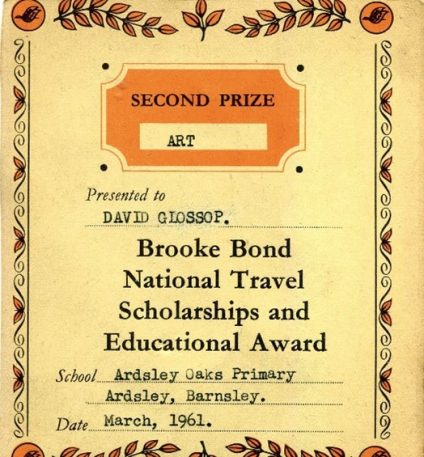
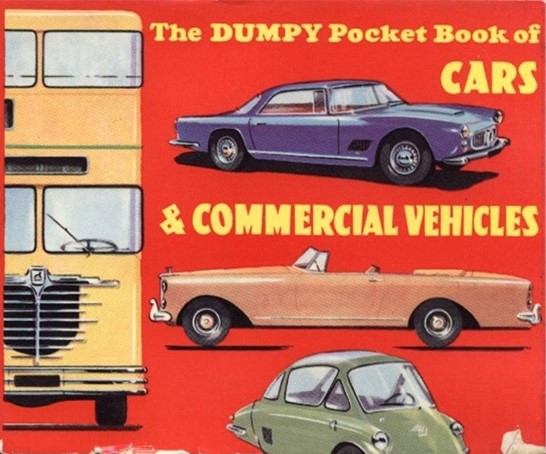
Trains & Railways
Around this time, trainspotting took hold of every lad in our class. This was helped greatly by our vantage point at school. The inside of the air-raid shelters still at Ardsley Oaks were strictly out of bounds. But as they’d been built half below ground level with a grassy covered top half, it was easy to climb on to the top. This provided a great view of Stairfoot Station and all trains working past. Barnsley Shed had closed shortly before in January 1960, and almost all of Barnsley’s locos had been transferred to Mexborough. They were however still performing the same duties as before. Thinking back it’s surprising as to how busy it was then. There would be a freight working (almost all coal) every few minutes, with either a Mexborough O4, or a Royston 8F or WD slowly rolling past. There wasn’t time in between for anyone to become bored.
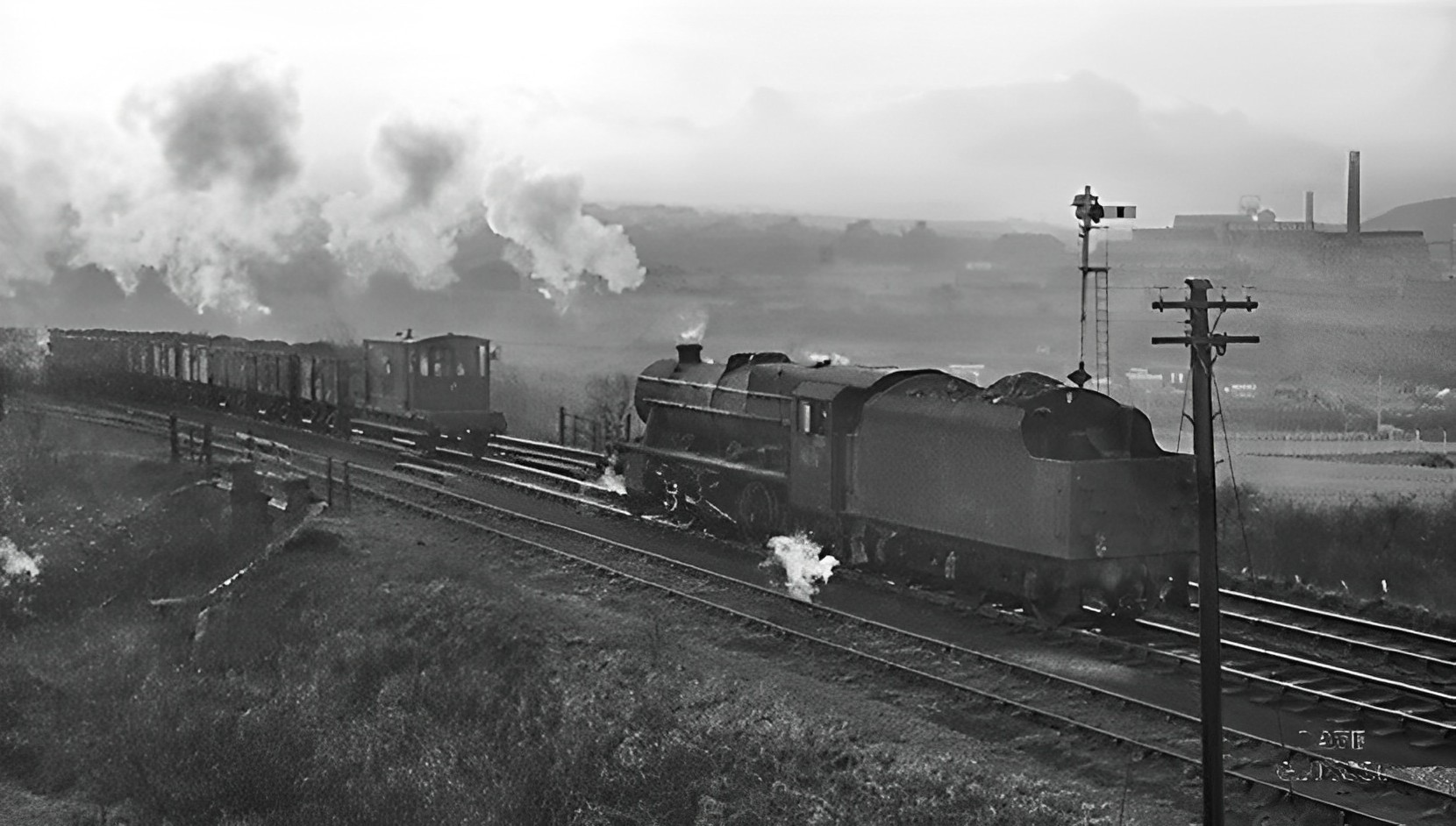
This is a few years later, after I owned a camera. Royston 8F 48113 on the last few yards of the Hull & Barnsley, heading for Stairfoot Station. After banking a coal train up the climb to Stairfoot, it now drops off and will soon return to run back light engine to Carlton. Beatson Clark’s can be seen on the right. 4th Feb 1967.
Another fond memory was of standing on Stairfoot Station one particular day with my mate Steven Kelsey. We were on the platform right alongside an O4 which was on the ‘Yortar’ siding, the rail access to the Yorkshire Tar Distillers’ Stairfoot works, when the driver asked if we wanted to climb up into the cab. After thinking about it for about a nanosecond, we were both in the cab. The driver then took us about 100 feet along the siding, and back again. No distance at all, as that was as far as it was possible to go. Now this might seem strange to some, but we were ecstatic !
The Midland line through Ardsley Tunnel and over Stairfoot Viaduct provided us with rather more glamorous subjects than the freight locos on the GC and H&B. To get to it we would go ‘darn’t Barley’ as we knew it. This was down a path at the end of Alexandra Terrace through a cornfield (hence the nickname) and onto a steep grassy field next to Ardsley Sidings. This line produced a couple of top link expresses every day. The star turn being the ‘Thames Clyde Express’ at around 3pm, usually hauled by a ‘Jubilee’ or increasingly by one of the new regime, a ‘Peak’ class diesel. On one unforgettable occasion – Saturday the 6th of Jan 1962 to be exact, the day after a heavy snowfall – a gang of us were having great fun sledging down the slope, when there came a roar from the direction of Ardsley Tunnel. It was the ‘Thames Clyde’, this time hauled by no less than Royal Scot, 46140 ‘The King’s Royal Rifle Corps’. To have the rare joy of sledging, and at the same time seeing a ‘Scot’ powering through the snowy landscape – well, days don’t get much better than that.
There was also an express freight which came through in the early hours each night. If I was awake, I could see in the distance from my bedroom window the glow in the cab from the firebox and hear the blast from the chimney as it roared across Stairfoot Viaduct towards Chapeltown. This was so exasperating as I couldn’t tell what any of these powerful beasts were. And to make matters worse, it was always steam hauled. So I came up with a plan. I arranged to meet up in the early hours, with my mate Steven Kelsey, who lived on Mount Street. Sneaking silently out of our house, armed with just a pocket torch, I reached the entrance to the footpath on Alexandra Terrace and found Steve waiting there already. We walked in pitch darkness with just the torch, eventually reaching the fence at the side of the line. After a few minutes we heard a roar coming from Ardsley Tunnel. I shone my torch as the train came past us, and to my surprise the beam was enough to light up the number on the cab – 45598, and then the nameplate – ‘Basutoland’. A Burton loco, and to our delight a ‘cop’ to boot. What a result ! I never dared tell my parents about our adventure, especially after leaving the house unlocked in the early hours. I sneaked silently back into bed without waking anyone. Nobody ever knew about our little adventure. Er – until now that is.
Stairfoot Feast
Every summer for one week Stairfoot Feast would arrive. It used to set up between the Keel Inn and the site of the former Tomlinson’s glassworks. This was greatly looked forward to by all of us kids, and we’d be there most days of the week. Before I was deemed old enough to go on my own though, my dad took me. After having a go on various rides, I persuaded my dad to go with me on the Waltzers. The ride started disappointingly as the ‘car’ we were in was just revolving slowly or even not at all. After a short while a young lad in charge of the ride came past and gave our car a mighty shove. It must have just been at a critical point, as the thing started spinning frantically and never slowed once. We were literally pinned to the back of the seat for the rest of the ride, totally unable to move. Thankfully the ride eventually came to end.
A minute or two after we’d staggered off, my dad realised he no longer had any money. Every penny had gone. The centrifugal force had drawn every coin out of his trouser pockets and onto the back of the Waltzer’s seat. We rushed back to the ride and found the car we’d been in. But the coins had already gone. That was that – it was time to go home.
Fame at last: My ‘TV Appearance’
In 1961 Barnsley reached the Quarter Final of the FA Cup, their best cup run for years. Division Three Barnsley had earlier held First Division Leicester to a draw. The replay was at Oakwell, and my dad took me and schoolmate Jimmy Hamer to watch the match. Somehow my dad managed to get us down to the very front of the stand, directly behind the low white painted wall that ran around the ground. By full time Barnsley was still holding Leicester to a 1-1 draw. Then in extra time, as is well known, disaster struck – Leicester scored. To our dismay, Barnsley were out of the Cup ! Now, the weather must have been rather mild for March, as I had taken my coat off and draped it over the low wall. After arriving home dad put the BBC News on. We didn’t know at the time but BBC cameras had been at the match and the highlights were on the news. As the camera panned across the ground, on the white painted wall in the distance, a tiny dark shape appeared. It was my coat. So the other tiny shape behind it had to be me. Oh, Wow ! I was on the telly !
A Punishment
The replay had to be played during an afternoon as this was in the days before floodlights at Oakwell. So quite a lot of Barnsley schools had given the pupils the day off to see this important match. But, Ardsley Oaks wasn’t one of them. Afterwards my Dad felt responsible for taking me out of school, and decided to send me the next day with a note of apology. The next morning me and Jimmy were summoned to see Mr Snowdon, the Headmaster, who it turned out wasn’t happy at all. We both got a severe dressing down. I then produced my ‘get out of jail free’ note and was sent back to our classroom, on my own. Jimmy appeared a few minutes later. It’s hard to believe in this day and age but, for not attending that previous afternoon, he had just received six strokes of the cane from the Headmaster.
Trouble in the Snow
I was getting ready for school one snowy December morning when I heard an enormous bang outside. Looking out of my bedroom window, I could see that two Yorkshire Traction single deckers travelling down the hill past Ardsley Oaks towards Stairfoot, had skidded in the snow colliding with each other rather badly. I quickly got dressed and went out with my camera and took these photos. Luckily no one was injured. Eventually the Tracky workshops rebuilt them both and put them back into service again, as good as new.
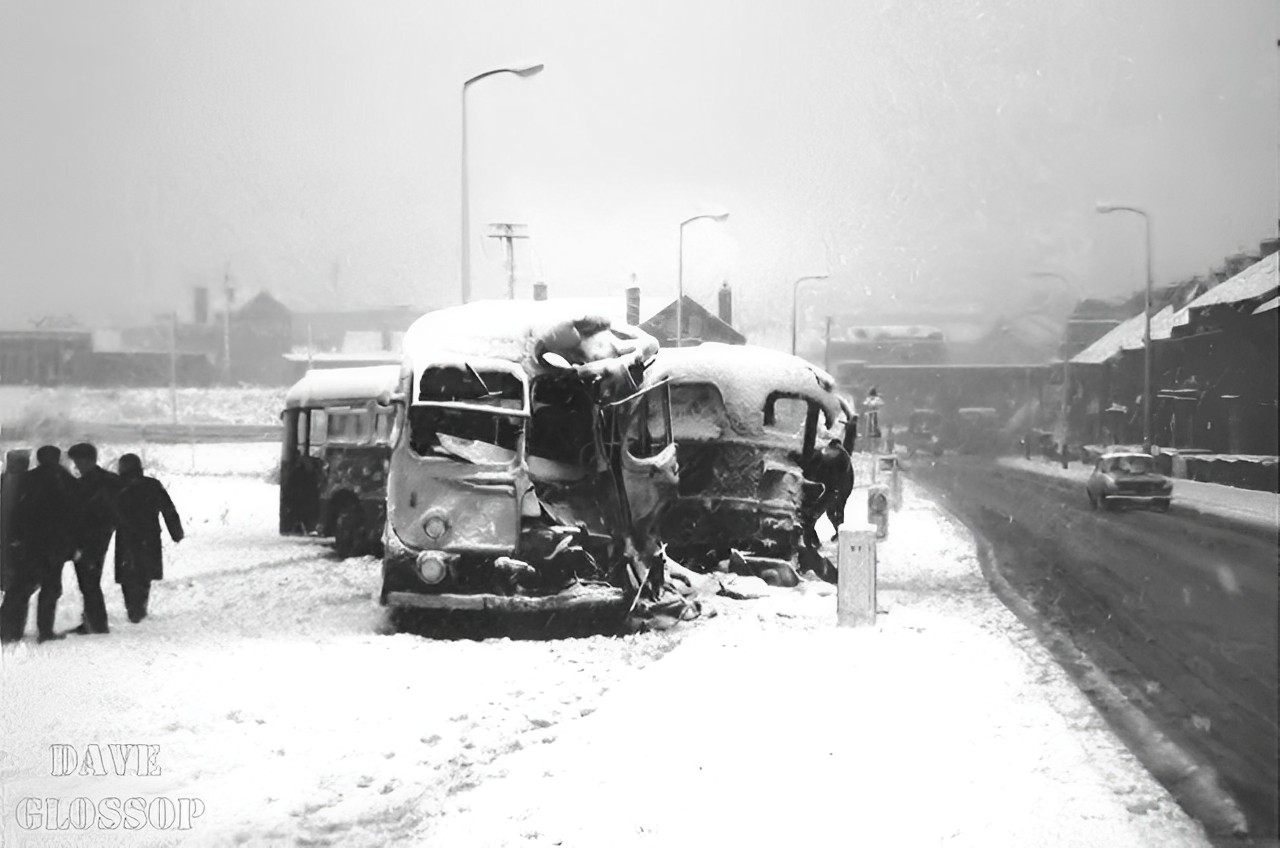
The view looking towards Stairfoot traffic lights. The accident is opposite the Ardsley Co-op. Stairfoot Station and the railway bridges are in the distance. Fortunately, being on the dual carriageway, two way traffic was able to continue by using the other carriageway.
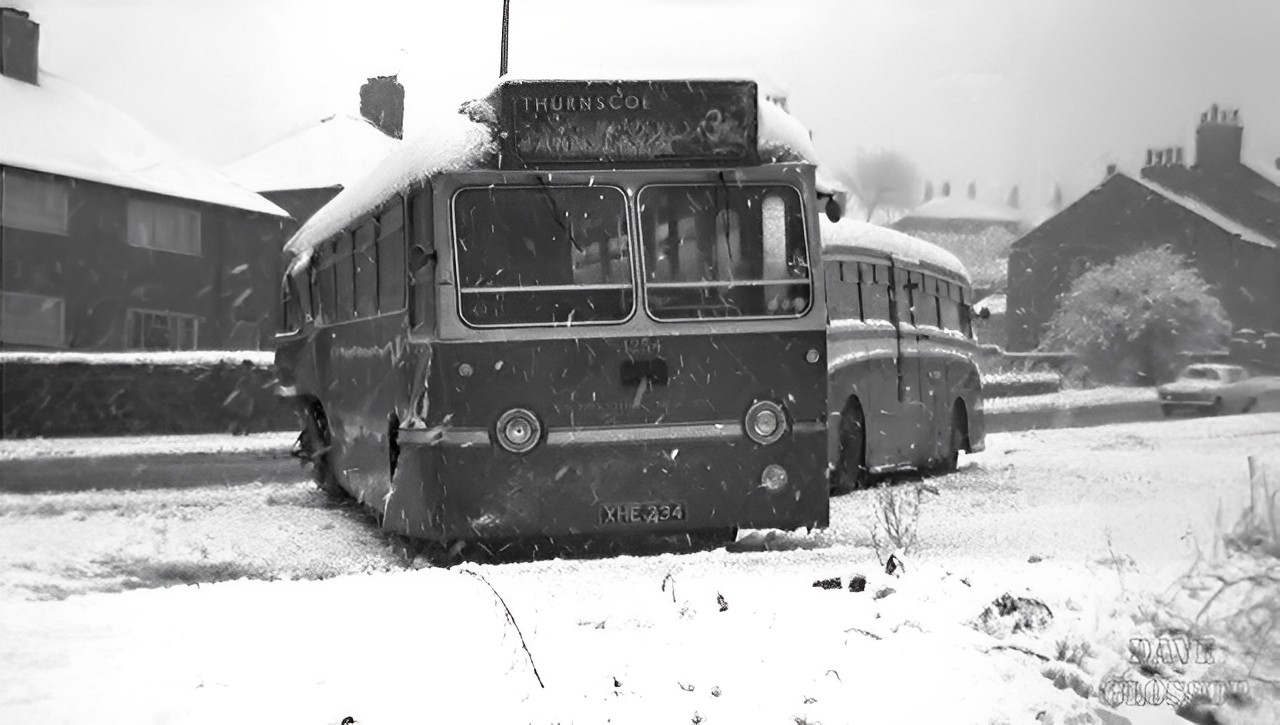
Looking up Doncaster Road.
For anyone interested: This is Tracky 1234 XHE234 a Leyland Leopard with Willowbrook bodywork, built in 1962, Behind is 1078 LHE506 a Leyland Tiger Cub coach with Burlingham Seagull bodywork built in 1957.
Our ‘Grand Prix Racetrack’
From the corner shop on Chapel Street, the road slopes down to Doncaster Road. The pavement of which provided a perfect gradient to hold our ‘Racing Car Championships’. About six or seven of us, along with our Dinky Toys racing cars, would gather, and from a notional starting line outside the corner shop, each car, with an almighty push, would be sent flying along the pavement. The furthest to travel was the winner.
Sadly my Ferrari, despite valiant attempts, never became a winner. By far the best car was one lad’s Maserati, which usually won. And this despite the driver not even having a head, after a previous incident. The best fun was to be had when the Ardsley bus turned the corner. The stop for passengers to alight happened to be about halfway along our racetrack. The sight of adults hopping about the pavement trying to avoid half a dozen Dinky Toys whizzing under their feet was a joy to behold.
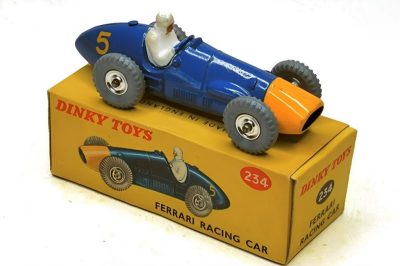
Looking Back
A cousin asked me a couple of years ago, what would be the things I would change from my childhood. After thinking for a while, I came up with the honest answer: None.
I can honestly say I had a truly happy childhood, despite everyone having very little money back then. To have grown up with such friendly and caring people, in a community where everyone looked out for one another, on looking back, I feel most fortunate.
For a child, the Ardsley of the 1950s & 1960s really was a wonderful place to grow up in.
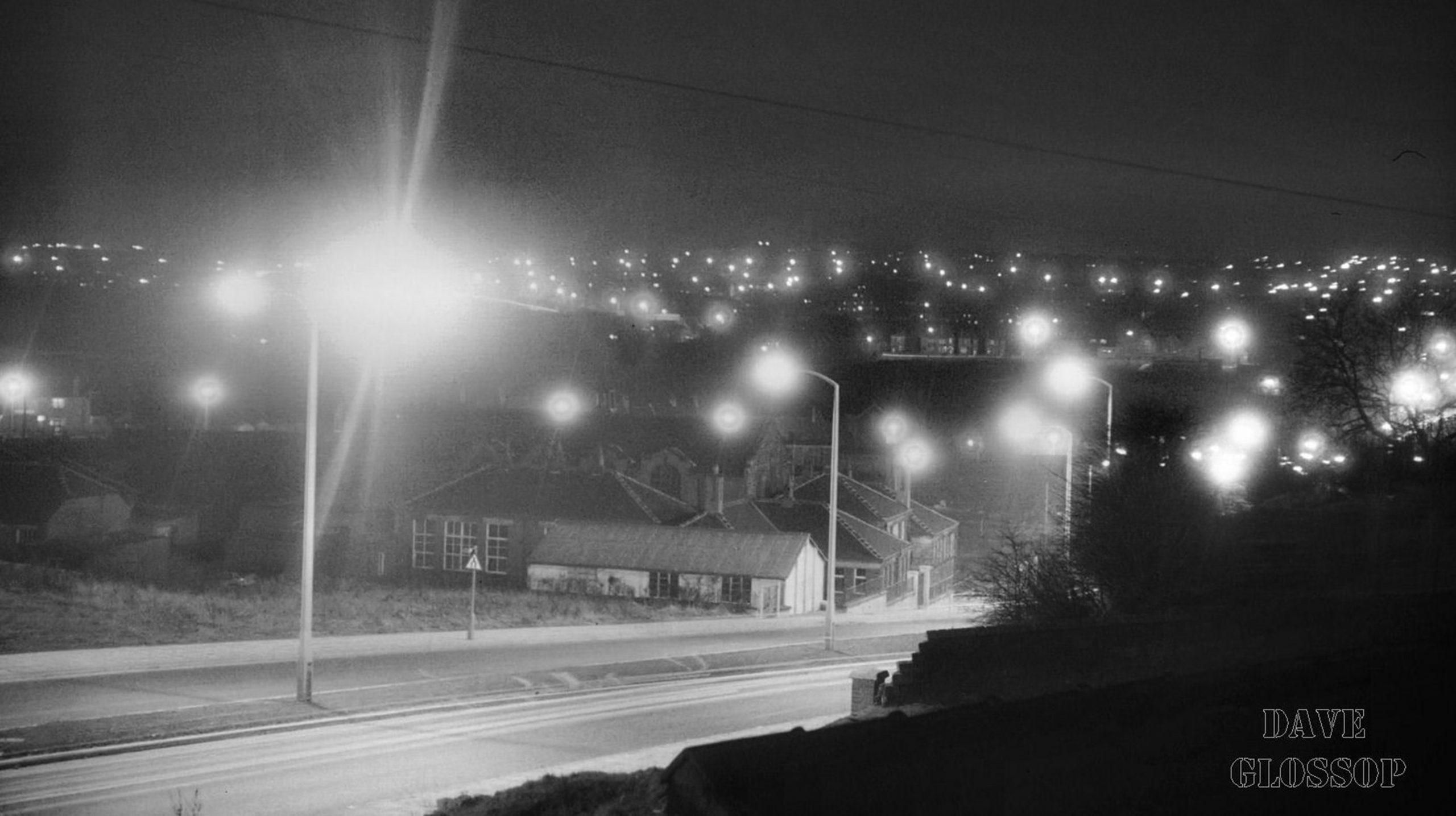
Ardsley and Stairfoot from my bedroom window. January 1968
Dave Glossop
March 2023
Stairfoot Station Heritage Park
Copyright © Stairfoot Station 2023 All right reserved.
Designed by Bits and Pieces Computers
